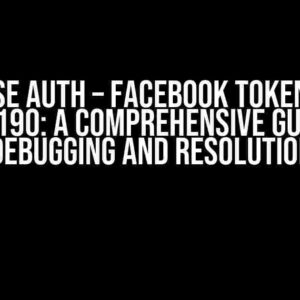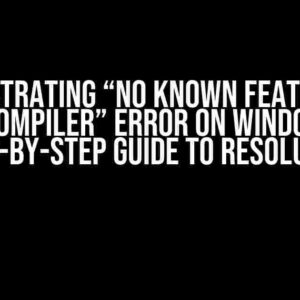Have you ever encountered the frustrating error “WTSQueryUserToken returning 0x0000000000000000” while trying to impersonate a user token in your application? You’re not alone! This error can be daunting, especially when you’re confident that an active session exists. Fear not, dear developer, for we’re about to dive into the world of Windows Terminal Services and uncover the reasons behind this enigmatic error.
Understanding WTSQueryUserToken
Before we dive into the troubleshooting process, let’s take a step back and understand what WTSQueryUserToken does. WTSQueryUserToken is a Windows API function that retrieves the impersonation token of a user connected to a terminal services session. This token is essential for impersonating the user and performing actions on their behalf.
WTSQueryUserToken(
ULONG SessionId,
PHANDLE pToken
);In the code snippet above, the function takes two parameters: SessionId, which represents the ID of the terminal services session, and pToken, which receives the impersonation token.
Causes of the Error
So, why does WTSQueryUserToken return 0x0000000000000000 (a NULL token) even when an active session exists? There are several reasons for this, including:
- Invalid Session ID: Passing an invalid or non-existent session ID to WTSQueryUserToken will result in a NULL token. Ensure that you’re using the correct session ID, which can be obtained using the WTSGetActiveConsoleSessionId() function.
- Lack of Permissions: The calling process must have the required permissions to query the user token. This includes the SeTcbPrivilege privilege, which can be enabled using the AdjustTokenPrivileges() function.
- Terminal Services Configuration: The terminal services configuration might be set to disallow user impersonation. Check the terminal services settings to ensure that user impersonation is enabled.
- Session Isolation: If the terminal services session is running in isolated mode, WTSQueryUserToken will return a NULL token. Session isolation is enabled by default in Windows Server 2008 and later versions.
- System Resource Issues: Low system resources, such as memory or handle leaks, can cause WTSQueryUserToken to fail and return a NULL token. Ensure that your system has sufficient resources and optimize your application’s resource usage.
Troubleshooting Steps
Now that we’ve identified the potential causes of the error, let’s go through the troubleshooting steps to resolve the issue:
- Verify the Session ID: Use the WTSGetActiveConsoleSessionId() function to obtain the active console session ID and ensure that it’s valid.
- Enable SeTcbPrivilege: Use the AdjustTokenPrivileges() function to enable the SeTcbPrivilege privilege for the calling process.
- Check Terminal Services Configuration: Verify that user impersonation is enabled in the terminal services settings.
- Disable Session Isolation: If possible, disable session isolation for the terminal services session.
- Optimize System Resources: Monitor system resources and optimize your application’s resource usage to prevent handle leaks and memory issues.
Code Snippet: WTSQueryUserToken with Error Handling
#include <windows.h>
#include <wtshelper.h>
int main() {
ULONG sessionId = WTSGetActiveConsoleSessionId();
HANDLE hToken = NULL;
if (WTSQueryUserToken(sessionId, &hToken) == FALSE) {
// Handle error
DWORD lastError = GetLastError();
LPSTR errMsg = NULL;
FormatMessage(FORMAT_MESSAGE_ALLOCATE_BUFFER | FORMAT_MESSAGE_FROM_SYSTEM | FORMAT_MESSAGE-ignore_inserts,
NULL, lastError, MAKELANGID(LANG_NEUTRAL, SUBLANG_DEFAULT),
(LPSTR)&errMsg, 0, NULL);
printf("Error: %s\n", errMsg);
LocalFree(errMsg);
} else {
// Use the impersonation token
printf("Impersonation token retrieved successfully!\n");
}
return 0;
}Conclusion
The “WTSQueryUserToken returning 0x0000000000000000” error can be a frustrating obstacle in your application’s development. However, by understanding the causes of the error and following the troubleshooting steps outlined above, you can resolve the issue and successfully impersonate the user token. Remember to verify the session ID, enable SeTcbPrivilege, check terminal services configuration, disable session isolation, and optimize system resources to ensure a smooth impersonation process.
| Cause | Solution |
|---|---|
| Invalid Session ID | Use WTSGetActiveConsoleSessionId() to obtain the correct session ID |
| Lack of Permissions | Enable SeTcbPrivilege using AdjustTokenPrivileges() |
| Terminal Services Configuration | Verify user impersonation is enabled in terminal services settings |
| Session Isolation | Disable session isolation for the terminal services session |
| System Resource Issues | Optimize system resources and prevent handle leaks and memory issues |
By following these guidelines and troubleshooting steps, you’ll be well on your way to resolving the “WTSQueryUserToken returning 0x0000000000000000” error and successfully impersonating the user token in your application.
Frequently Asked Question
Get the answers to the most frequently asked questions about WTSQueryUserToken returning “0x0000000000000000” hImpersonationToken even when there is an active session.
What is WTSQueryUserToken and why is it important?
WTSQueryUserToken is a Windows API function that retrieves the impersonation token of a user connected to a remote desktop connection. It’s crucial for scenarios where you need to impersonate the user, such as accessing resources on their behalf or performing tasks under their security context.
What does the “0x0000000000000000” hImpersonationToken return value mean?
The “0x0000000000000000” return value indicates that the impersonation token is invalid or not available. This can happen if the user is not connected to the remote desktop, or if the token is not generated correctly.
Why is WTSQueryUserToken returning “0x0000000000000000” even when there is an active session?
There could be several reasons for this, including issues with Windows authentication, Remote Desktop Services configuration, or problems with the user’s account or profile. It’s essential to troubleshoot these potential causes to resolve the issue.
How do I troubleshoot WTSQueryUserToken issues?
To troubleshoot WTSQueryUserToken issues, enable Windows Event Logging for Remote Desktop Services, check the system and application event logs for errors, and verify that the user account is properly configured and authenticated. You can also test the WTSQueryUserToken function with different user accounts or in different scenarios to isolate the problem.
Are there any alternative methods to retrieve the impersonation token?
Yes, you can use the DuplicateTokenEx function as an alternative method to retrieve the impersonation token. This function creates a duplicate of an access token, which can be used for impersonation. However, be aware of the security implications and ensure proper error handling when using this function.



